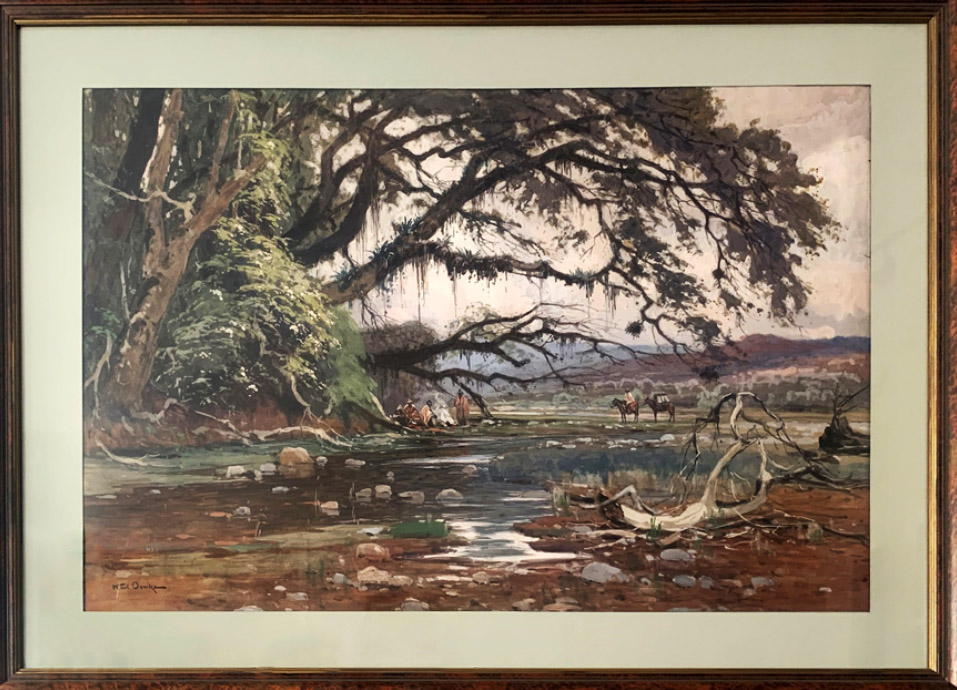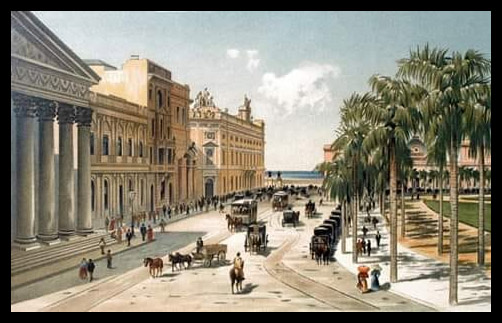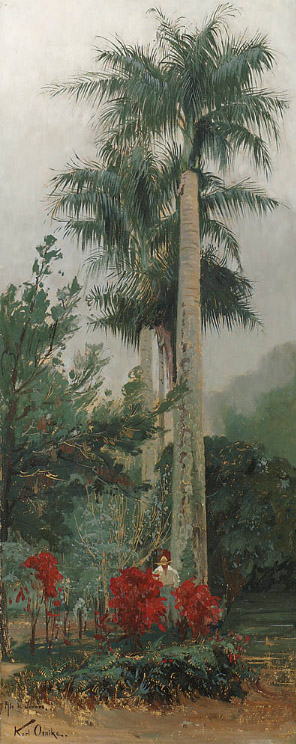To celebrate its ten years of existence, the DIHA Center held an exhibition of Oenike's drawings and photographs at the German Club of Buenos Aires in October 2023, curated by the historian and image specialist from the National University of San Martín, Inés Yujnovsky, and by one of Oenike's great-grandchildren, Roberto Liebenthal. Always with the interest of disseminating his work, other exhibitions are scheduled in different institutions this year. These are drawings of landscapes and people reproduced and gathered in about 20 panels, along with photographs obtained by that traveler. The texts that accompany the images have been carefully chosen from the artist's travel diaries, which fortunately are preserved in the Ibero-American Institute in Berlin, along with other materials donated by his descendants.
Oenike had trained in Berlin and coincided in Argentina with the last years of the long stay of the painter and antiquarian Adolf Methfessel (1836-1909), although he does not seem to have known him. An art historian, Herman Ten Kate (1858 - 1931), a contemporary of theirs, mentions both with admiration.
Friendly relations took him to Buenos Aires in 1887, to the house of a colleague of his father, Wilhelm Carl Fehling, a manufacturer of carts and floats. Fehling had settled in Argentina and, together with his children, would shortly later become a prominent automobile importer. From the Fehling house he made trips through the interior of the country lasting several months, first to Córdoba, then twice to the northwest of Argentina, to Catamarca and La Rioja, and then to Salta. He was lucky enough to make the first of these excursions as a companion of a renowned naturalist researcher, Ludwig Brackebusch, who took him through high mountain passes to the hidden mines, on his eighth and last exploration trip, before returning to his university work. in Germany. In the Argentine mines they worked then under primitive conditions, about which Brackebusch later wrote an article illustrated with pregnant images taken by his young colleague [1]. They spent four months passing through these inhospitable lands, accompanied by a laborer and some soldiers. Numerous drawings and photographs by Oenike bear witness to these months, as well as the diary he wrote during the trip, of which three more or less matching copies have been preserved.
After a rest Oenike made another expedition, accompanied only by a laborer he already knew from his previous trip. They did not move now through the desert heights of the Cordillera and foothills but through the lush landscape of Salta, with its mighty rivers and its wealth of tree species and plants of all kinds. Once again he made numerous drawings, made a photographic record and wrote a diary with brief summaries of what happened from day to day, the people he met, the places that welcomed him, furtive camaraderie with Germans or English who worked in the area, the climate and its changes, the remarkable flora and fauna, and even the state of health of the writer himself. Little in terms of considerations that transcend what has been seen and experienced. These diaries constitute another source, alongside what we find represented in images, but they were only preserved from these two trips.
The cartoonist made other excursions of unknown duration within Argentina and in the surrounding countries. He was twice in Paraguay, later describing in several articles, above all, traces of Germans who had settled far from Asunción. He joined the Austrian naturalist Paul Jordan to climb Cerro Tatuy, 700 meters high, which had not yet been climbed by Europeans, and they found not the Guayaquí Indians themselves, but some primitive Indian huts, which he drew and later made available to anthropologist Paul Ehrenreich to illustrate an investigation. He was in Brazil between July and October 1890, carrying out new works.
Back in Germany, Oenike himself wrote several articles for German travel magazines [2] about his stays in Paraguay and about the experiences collected in the four years he spent in Argentina. In the second half of the 19th century, this type of testimonial stories captivated the public's interest in learning about the exotic extra-European world. He wrote about the gaucho, about the saladeros in the province of Entre Ríos and other regional topics, illustrating his texts with drawings and photographs, and he collaborated with his own works to make some engravings that were included in articles by other authors. . The exceptional book by Brackebusch has already been mentioned, which is accompanied by 15 very expressive engravings. He edited some postcards with South American themes that he probably did not experience himself, such as the ruins of Tiahuanaco or the colonization of Pozuzo, a German town in central Peru.
The originals of the drawings and photographs exhibited are today in the Linden Museum, an ethnographic museum in Stuttgart, Baden-Württemberg, which allowed reproduction. Other works by the painter are in museums and in private hands. There are no other studies known about this painter and photographer, apart from those included in the Archive Notebook 11/12 (2022), although several of the themes represented in his iconographic work are of exceptional cultural value.
There are few works by Oenike referring to the Argentine adventure; One of them, an oil painting, constitutes a beautiful record of the Río de las Piedras, in Salta, property of one of Oenike's great-grandsons who resides in Buenos Aires. A colored lithograph is preserved in the Banco Nación: Buenos Aires: Plaza de Mayo mit Dom und Nationalbank - c. 1887 -1891, 38 x 43 cm, which is part of his art collection [3].
That traveler married a daughter of Fehling and in 1891 he returned to Berlin, where he was successful as a painter of landscapes and works of a historical and building nature, and gave painting classes. He made trips through Germany, northern Europe and the Near East, and lived with his family in a splendid house of their own in Berlin, raising his four daughters there. The trip to South America was a topic of relevance to his family, who repeatedly tried to publicize it. It would be beautiful if with the exhibition and the new publications Oenike gained well-deserved recognition as a traveling chronicler, since he produced unique images of Argentine themes.
Notes:
1. There is a translation of this article published as a book.
2. There are seven known articles with South American themes, of which four have been translated into Spanish and published in the Cuadernos del Archivo No. 11-12, in a dossier dedicated to Oenike in Argentina.
3. Works from the Banco de la Nación Argentina Collection, Catalog, pp. 38-39.
* Special for Hilario. Arts Letters Trades


